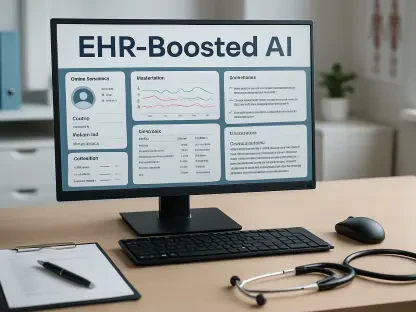In an era where healthcare systems are grappling with unprecedented demands, Radiology Information Systems (RIS) have emerged as a pivotal force in reshaping how radiological imaging and workflows are managed across hospitals and clinics worldwide. These specialized software platforms are designed to streamline critical tasks such as patient scheduling, order entry, reporting, and data sharing, enabling healthcare providers to deliver faster and more accurate diagnoses. Valued at USD 0.868 billion in 2025, the global RIS market is projected to grow to USD 1.34 billion by 2034, reflecting a compound annual growth rate (CAGR) of 4.3%. This remarkable trajectory underscores the growing reliance on digital solutions to address the complexities of modern healthcare. RIS is not merely a tool for administrative efficiency; it represents a fundamental shift toward technology-driven care that prioritizes precision and patient outcomes. As the healthcare landscape continues to evolve, understanding the transformative power of RIS becomes essential. This exploration delves into the ways these systems are revolutionizing medical imaging through innovation, integration, and adaptability, while also addressing the challenges that accompany such rapid progress. From cutting-edge cloud and AI technologies to regional adoption trends, the impact of RIS promises to redefine the future of healthcare delivery on a global scale.
Driving Efficiency Through Digital Transformation
The adoption of Radiology Information Systems marks a significant step in the digital transformation of healthcare, particularly within radiology departments facing mounting pressure to manage increasing imaging volumes. These systems tackle the challenge head-on by automating time-consuming administrative tasks such as scheduling appointments, tracking patient data, and handling billing processes. By reducing the burden of manual work, RIS allows radiologists to dedicate more time to interpreting images and engaging with patients, ultimately enhancing the quality of care. This shift toward automation is not just a convenience but a critical response to the growing demand for faster turnaround times without compromising diagnostic accuracy. Hospitals and clinics adopting RIS have reported noticeable improvements in workflow efficiency, which translates to shorter wait times for patients and a more streamlined operational environment for staff. The push for digital tools like RIS reflects a broader recognition that technology must play a central role in meeting the escalating needs of modern healthcare systems.
Beyond immediate operational gains, RIS serves as a foundation for a more connected and responsive healthcare model. The ability to digitize and centralize radiology workflows ensures that data is readily accessible to relevant teams, fostering better communication across departments. This connectivity is vital in settings where multidisciplinary collaboration is key to effective patient management. Moreover, the scalability of RIS means that it can adapt to facilities of varying sizes, from large hospital networks to smaller outpatient centers. As healthcare providers continue to grapple with resource constraints and rising patient expectations, the role of RIS in optimizing processes becomes increasingly indispensable. The sustained growth in the market signals a collective acknowledgment that digital transformation, powered by systems like RIS, is not a passing trend but a permanent fixture in the evolution of medical care.
Leveraging Cloud and AI for Smarter Workflows
The integration of cloud-based platforms into Radiology Information Systems has introduced a new level of flexibility and efficiency that traditional on-premises systems struggle to match. Cloud RIS enables remote access to critical data, allowing radiologists to review cases and collaborate with colleagues from virtually any location. This capability is particularly transformative for smaller clinics and rural facilities, where access to specialized expertise may be limited. Additionally, cloud solutions offer scalability, meaning healthcare providers can adjust their systems based on demand without incurring prohibitive costs. The cost-effectiveness of this approach makes advanced radiology tools accessible to a wider range of institutions, breaking down barriers that once restricted technological upgrades to only the largest hospitals. As a result, the adoption of cloud-based RIS is accelerating, reshaping how imaging workflows are managed across diverse healthcare settings.
Complementing cloud technology, the incorporation of artificial intelligence (AI) into RIS platforms is revolutionizing diagnostic processes by adding a layer of intelligent automation. AI algorithms can analyze imaging data to prioritize urgent cases, flag potential abnormalities, and even suggest preliminary insights, significantly reducing the time needed for critical decisions. Far from replacing human expertise, these tools empower radiologists by handling repetitive tasks, thereby allowing them to focus on complex interpretations and patient care. The synergy of AI with RIS also extends to predictive analytics, which can forecast equipment maintenance needs or patient volume trends, further optimizing resource allocation. This marriage of cloud accessibility and AI-driven intelligence positions RIS as a cornerstone of next-generation healthcare, where speed, accuracy, and adaptability converge to improve outcomes on a global scale.
Bridging Gaps with Seamless Interoperability
A defining feature of modern Radiology Information Systems is their ability to integrate seamlessly with other healthcare IT platforms, such as electronic health records (EHRs) and picture archiving and communication systems (PACS). This interoperability addresses a longstanding challenge in healthcare: the fragmentation of data across disparate systems that hinders effective communication. By enabling smooth data exchange, RIS ensures that radiologists, clinicians, and administrative staff have access to a unified view of patient information, minimizing errors and redundancies. For large hospital networks, where multiple departments must coordinate care, this connectivity is invaluable in maintaining consistency and efficiency. The result is a more cohesive approach to patient management, where every stakeholder operates with the same up-to-date information, ultimately enhancing the quality of care delivered.
The emphasis on interoperability also aligns with global healthcare trends pushing for value-based care models, where outcomes take precedence over procedural volume. RIS platforms that integrate well with existing infrastructure support this shift by facilitating data-driven decision-making and ensuring continuity across treatment stages. Regulatory bodies and policymakers, especially in regions like North America and Europe, are increasingly mandating standardized data-sharing protocols, further elevating the importance of interoperable systems. As RIS evolves to meet these requirements, it becomes a linchpin in creating a healthcare ecosystem where technology fosters collaboration rather than division. This focus on integration not only streamlines radiology workflows but also sets a precedent for how interconnected systems can transform the broader medical field.
Navigating Market Dynamics and Barriers to Adoption
The growth of the Radiology Information Systems market is fueled by an urgent need for efficient workflow management in healthcare facilities grappling with high imaging demands. The ability of RIS to automate processes and improve communication across teams is a key driver, as it directly addresses the pressure to deliver timely results without sacrificing accuracy. However, significant challenges temper this momentum, particularly the high costs associated with implementation and maintenance. Smaller clinics and diagnostic centers often find the financial burden of licensing, training staff, and updating systems prohibitive, slowing adoption rates in resource-constrained environments. This disparity highlights a critical gap in ensuring that the benefits of RIS reach all segments of the healthcare spectrum, not just well-funded institutions.
Despite these financial hurdles, opportunities for broader adoption are emerging through innovative deployment models like cloud-based RIS, which drastically reduce upfront expenses. These solutions appeal to mid-sized and smaller facilities by offering scalable options that align with limited budgets while still delivering robust functionality. Yet, even as cost barriers are addressed, data security remains a pressing concern. With RIS managing sensitive patient information, especially in cloud environments, the risk of cyberattacks looms large, necessitating substantial investments in cybersecurity to protect against breaches and maintain regulatory compliance. Balancing these dynamics—cost, accessibility, and security—will be crucial for vendors and providers alike to ensure that RIS can fulfill its transformative potential across diverse healthcare landscapes.
Understanding Regional Impacts and Growth Patterns
North America leads the Radiology Information Systems market, driven by a robust healthcare infrastructure and a proactive approach to adopting digital health technologies. The United States, in particular, benefits from substantial investments in research and development, alongside government initiatives that encourage the integration of advanced IT systems in medical settings. This region’s early embrace of cloud and AI-driven RIS solutions has set a high standard for operational efficiency and innovation, making it a benchmark for others. The focus on value-based care further reinforces the adoption of RIS, as providers prioritize tools that enhance patient outcomes through seamless data management and workflow optimization. North America’s dominance underscores how supportive policies and technological readiness can accelerate the impact of such systems.
Europe follows with a distinct emphasis on interoperability and stringent data protection regulations, reflecting the region’s commitment to secure and efficient healthcare delivery. Public healthcare systems across the European Union are modernizing their IT frameworks, with RIS playing a pivotal role in enabling cross-border collaboration and reducing diagnostic delays. The priority on compliance ensures that vendors develop solutions tailored to meet rigorous standards, fostering trust among providers and patients alike. Meanwhile, Asia stands out as a high-growth area, propelled by rapid healthcare infrastructure expansion in countries like China and India. Cloud-based RIS is gaining traction here due to its affordability, addressing the need to manage rising patient volumes in both urban and rural settings. These regional variations illustrate how RIS adapts to local priorities, from innovation in North America to compliance in Europe and scalability in Asia, shaping healthcare transformation on a global scale.
Charting the Future of Radiological Innovation
Looking ahead, the sustained growth of Radiology Information Systems promises to redefine the landscape of healthcare through continuous technological advancements and an unwavering focus on integration. The increasing adoption of cloud-based and AI-enhanced platforms is set to accelerate, particularly in emerging markets where cost-effective scalability is paramount. Interoperability will remain a central theme, as global healthcare systems strive for seamless data exchange to support coordinated, patient-centered care. Addressing persistent challenges, such as high implementation costs and data security risks, will be critical to ensuring that the benefits of RIS are accessible to facilities of all sizes and across all regions. Vendors must innovate with flexible, secure solutions, while policymakers can play a role in easing financial barriers through supportive frameworks.
The implications of this trajectory extend beyond radiology, offering a blueprint for how digital tools can transform broader healthcare delivery. Stakeholders, including healthcare providers, must prioritize partnerships and training initiatives to maximize the potential of RIS, ensuring staff are equipped to leverage these systems effectively. Additionally, a renewed commitment to cybersecurity measures will be essential to safeguard sensitive data and maintain trust in an increasingly digital environment. As RIS continues to evolve, its role in enhancing diagnostic precision, reducing operational inefficiencies, and ultimately improving patient outcomes cannot be overstated. This journey of innovation and adaptation signals a future where technology and healthcare are inseparably linked, paving the way for a more responsive and interconnected medical ecosystem.









